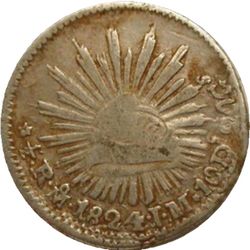New 1824 Mo Hookneck ½ Real Eagle Die Reported
by David Hughes
The first coins of the Mexican Republic were the attractive “hookneck”, or profile eagle coins, struck by the mints at Mexico City (Mo), Durango (Do) and Guanajuato (Go). They were somewhat inconsistently issued from 1823 to 1825 (i.e., whereas the Go mint was striking the hookneck in 1825, the Mo mint had switched to the facing eagle in 1824T.V. Buttrey and Clyde Hubbard, A Guide Book of Mexican Coins, 1822 to Date, sixth edition, Krause Publications, Iola, WI, 1992: poor internal communication within the new republic is the probable reason). The ½ real (Mo), 1 real (Do, rare), 2 real (Do, Mo) and 8 real (Do, Go, Mo) were struck in silver, and the 8 escudo (Mo) was struck in gold. In general, the coins from the Mo mint are the more available of the series.
In my (probably ultimately futile and certainly slow moving) attempt to assemble a República type set, I acquired an 1824 Mo hookneck ½ real at a local coin show that put the ug in ugly. It is so ugly I have not even typed it in the excellent reference book HookneckClyde Hubbard and David O’Harrow, Hookneck, privately published, 1997:/footnote}. I figured something better would come along, and sure enough, a nice looking VF appeared on eBay, and I obtained it without too much struggle or grief.
When the piece arrived, I happily plunged into Hookneck to type it. However, the longer I looked at it, the more I felt it wasn’t described in either Hookneck or the Supplement to HookneckClyde Hubbard and David O’Harrow, A Supplement to Hookneck, privately published, 2001Hubbard and O’Harrow, 2001).


The Liberty cap die is a Type 4 (p.58/59 in Hookneck). All the die markers are there, including the small tool mark to the right of the 1 in 1/2. This side is slightly double struck in the 10 Ds 20 Gs area and along the bottom rim, perhaps explaining why LIBERTAD is so weak on an otherwise nice VF coin.
The Eagle side, though, is obviously not a Type 4. It is closest to, but different from, the Type 2 die. This makes me think it was produced toward the middle or end of the die production, and is a sibling to the Type 2 die, cut when the engravers at the mint were used to making the die and had achieved some amount of similarity between the dies.
The differences with Type 2 are:
• P of REPUBLICA set higher than the E or B and slightly rotated clockwise relative to Type 2
• If you connect the tops of P and B in REPUBLICA, the U is lower than Type 2
• L of REPUBLICA is also slightly rotated clockwise relative to Type 2
• M of MEXICANA is set even with the E, not higher as in Type 2 (as far as I can tell from the plate in the book)
• The eagle left wing tip is more centered under the I of MEXICANA
• The first A in MEXICANA is set more even with the C and N, not raised like the Type 2
• The final A in MEXICANA might be repunched, or there are tool marks under the A. There also appears to be a tool mark to the left of the N in MEXICANA
• There are fewer water lines under the cactus than the Type 2
• The left center cactus pad has short spines, not the long spines on Type 2
• On the right cactus pad, the upper spines point to the right, not the left as on the Type 2
• The snake head terminates under the center of the letter E upright, unlike the Type 2 that terminates on the left side of the letter E upright in REPUBLICA
Finally, probably the biggest difference is that there is a die break through the B in REPUBLICA, from the rim through the B to the eagle wing, and along the top of the right wing to the left wing. It looks like it originated along the upright of the B, hence to the rim, and subsequently to the eagle wing.
Other details on the Eagle die seem fresh (the detail is not mushy, there are no clash marks or die chips, and there are no apparent flow lines or ridges, the appearance of which would indicate a worn die). This suggests to me the Eagle die cracked and failed relatively early in the striking, and they subsequently pulled it off and replaced it with the Type 4 Eagle die.
After email exchanges of descriptions and photographs with David O’Harrow, he agrees this is a new, previously unreported Eagle die. Due to the apparent early die failure, this also appears to be a rare variety, being the first time it has come to his attention in the 14 years since Hookneck was published. Continuing the numbering in the Supplement to Hookneck, this would be Eagle die Type 6 (new) matched with Cap die Type 4, making the sixth variety of the 1824 Mo hookneck ½ real reported.
